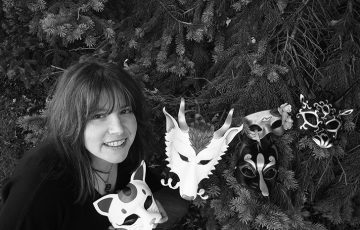 Rebecca Rayborn was born on March 6, 1984. Her father is British. In 2008, she replaced Ueto Aya as Japan’s ‘CM Queen,’ an accolade which is awarded to the star who appears in the most TV commercials in a year – in other words, Japan’s most marketable face. Never heard of her? Don’t worry, under this moniker few have. Her gei-mei or stage name is Becky and she is perhaps the most prominent of Japan’s new wave of hafu-tarento – television stars who have one Japanese and one foreign parent.
Rebecca Rayborn was born on March 6, 1984. Her father is British. In 2008, she replaced Ueto Aya as Japan’s ‘CM Queen,’ an accolade which is awarded to the star who appears in the most TV commercials in a year – in other words, Japan’s most marketable face. Never heard of her? Don’t worry, under this moniker few have. Her gei-mei or stage name is Becky and she is perhaps the most prominent of Japan’s new wave of hafu-tarento – television stars who have one Japanese and one foreign parent.
For those of you with a less than tolerant eye for Japanese television, people who, for example, value their sanity, recent years have seen a boom in half Japanese celebrities. They represent a variety of fields, from actresses Kato Rosa and Kuroki Meisa to models Michibata Jessica and Tsuchiya Anna to newsreader Takigawa Christel, baseball star Darvish Yu, and singers such as Kimura Kaera and Angela Aki.
There was a time when a TV show in Japan featuring a non ‘pure’ Japanese was a rarity. Now however, switch on any channel at any time of day and the chances are that you will be watching someone with mixed roots, and we’re not just talking hair.
Television networks have recently begun to specifically favor mixed-race talent for their shows. Takigawa Christel, for example, failed to impress Fuji TV using her given name of Masami but was later hired back from Kyodo TV using the French middle name for which she has now become famous. Christel, apparently, is that little bit more ‘exotic.’
The term hafu was coined from the English word ‘half’ in the seventies to describe people of mixed race. It may not be overly popular among parents of biracial kids these days, but compared to some of the previous alternatives, it doesn’t seem, if you’ll excuse the pun, half bad. Ainoko, meaning child born of the ‘meeting’ of two races, was common after World War II and certainly pulled no punches, while a later phrase konketsuji, which literally means mixed blood, is also considered derogatory. The thing is, these terms were meant to be derogatory.
Not too long ago, hafu kids were dirty secrets in Japan, just as they were in many other so-called ‘civilized’ countries. They were hushed up, sent away to an uncle’s farm in the country, disowned. Now they’re on the cover of Non-no.
Becky’s appeal to the Japanese public would seem to have little to do with her mixed heritage, though. It is her genkisa or perkiness which is usually quoted as her most redeeming feature, but it’s not the reason for her initial success. Becky got her big break in 1999 on a show called Oha-Suta, reading out the names of Pokemon characters in English, a job obviously far beyond the capabilities of any Japanese person. This was extremely indicative of the expected contribution of hafu-tarento in the past.
These days, Becky speaking English on camera is about as common as someone mentioning that her father isn’t Japanese. She has, in a manner of speaking, worked her way from the outside in – an archetype of assimilation.
Wentz Eiji – another TV presenter – has somewhat built his on-screen personality around not being able to speak English, despite having an American father. It’s almost his selling point. He is hafu, but the friendly non-threatening type that isn’t going to surprise anyone with a burst of fluent gibberish in a foreign language.
Still, the fact that they have been able to become so popular is certainly something of an indicator of the way in which Japanese society has begun to accept the phenomenon of mixed race marriages and children over the last ten to twenty years.
Japan in the eighties and nineties saw a boom in international marriages and mixed race babies as foreign companies rushed headlong into the bubble and then sat around in the soapy mess after it burst, wondering how to get out. The fruits of those years are now in their late teens and early twenties and becoming a highly visible segment of the Japanese population, certainly in magazines and on television.
Whether television is the best, worst, or in fact a non-indicator of societal change is certainly open to debate, but one thing is for sure – with television, you never get the full picture.
Homosexual men, transvestites, transgendered individuals, and even just cross-dressers feature heavily on Japanese TV, and in many cases are idolized. There is certainly nothing wrong with that. Coming from Britain, having it all out in the open seems rather refreshing to me. The problem is the unseen discrimination hidingof Shinjuku Ni-Chome, is still frowned upon (or ignored) in most sections of Japanese society. While housewives can’t get enough of the antics of the crossdressing phenom that is Ikko or transgendered comedian Haruna Ai, if their own son wanted to take that route, their reaction would not likely be as positive. As for hafu tarento, it seems the situation isn’t so different. They are, to an extent, revered on TV, but not so lauded in real life.
Brian Harlow and his wife have three hafu children. Brian, an American now residing in Kamagaya, Chiba feels that attitudes to mixed race people in Japan are changing, but not enough. “When the kids are out with their mother, they’re Japanese.” He said, “They’re unflinchingly accepted into the system. When they’re with me, things are a bit different – funny looks and people presuming they can’t speak Japanese.”
This double life, where nationality is dependent on which parent accompanies a child has led to increasing use of the term ‘double’ for mixed race kids. Hafu has long been rejected by some parents who dislike the perceived negativity attached to it. ‘Half of what exactly?’ they ask, ‘Half a person? Not my child.’
Double has the opposite connotation, promoting mixed genes as a benefit to a child. Unfortunately, it doesn’t seem to really get to the root of the problem: helping free children from discrimination in any shape or form. ‘Double’ sounds contrived – desperate even – and will probably not catch on, certainly not amongst the Japanese. The problem is, if not hafu, then what?
Positive or negative tags aside, children of mixed marriages will always be viewed differently – something which has a lot more to do with mindsets than eyes. “If a Japanese child does something disrespectful,” says Harlow, “they are soon excused, but I sometimes feel that with my kids, it is talked about for longer by other parents, not so easily forgotten. They are under the microscope 100% of the time.”
International marriages account for roughly 5% of all unions in Japan. The vast majority of these – some 80% – are between Japanese males and Asian females (mainly from China, the Philippines and Korea). Of the other 20% between Japanese females and foreign males, Korean and Chinese males make up more than half. In other words, most international marriages are between Japan and its neighboring countries. This isn’t really reflected, though, in TV stars’ hafu heritage.
 Becky’s father is British, as is Kimura Kaera’s. Tsuchiya Anna and Wentz Eiji are both half-American, Takigawa Christel is half-French, Kato Rosa, half-Italian.
Becky’s father is British, as is Kimura Kaera’s. Tsuchiya Anna and Wentz Eiji are both half-American, Takigawa Christel is half-French, Kato Rosa, half-Italian.
In fact, almost all of the new wave of half-Japanese celebrities are born to a European or North American parent, and in most cases that parent is the father. The father part could well be attributed to the fact that the majority of Westerners who come to work in Japan are male, but the European/American slant is slightly odd. The lack of half-Brazilians or Peruvians on TV, for example, is also puzzling, but could be attributed to economic factors, among many other things.
Again, we’re brought back to this notion of exoticism. Half-Korean or Chinese children on the whole don’t look as different from pure Japanese kids as western hafu do. TV personalities such as Takigawa, and erstwhile bad girl Yamamoto Mona have big round western eyes, a feature very highly valued among Japanese women (and men presumably, in Yamamoto’s case). There is perhaps a familiar Japanese ‘something’ lurking in their faces, but also an element of mystique.
This in essence is the trick – it’s what TV producers and magazine talent spotters look for. A mix of the exotic and the familiar is something that neither Japanese people nor foreign people can ever possess. Only one group of people really can. This is, if you will, the half niche.
The inner workings of Japan’s cult of TV celebrity are about as intelligible – and indeed interesting – to most normal people as the calculations behind superannuation, and it’s certainly a fierce world where stars come and go with alarming alacrity.
The thing with this hafu boom is that it isn’t really a boom at all, but more of a gradual shift. Shifts, unlike booms, are built slowly and to last. Foreign personalities in Japan such as Bob Sapp usually have the staying power of a paper tent in a typhoon, but any such notions that hafu celebs like Becky will disappear are way off the mark. Even if their current popularity fades away, they are here to stay. They are insiders looking out – Japanese in speech, Japanese in nature, and Japanese in all but half their blood.
One thing is for sure; foreign people are not going to stop marrying into the Japanese population, not unless the country closes down again and re-divides itself into shogunates. In all likelihood, the number of international marriages in Japan will rise considerably as Japan’s aging population looks to import foreign workers, especially in the care and nursing sector. And while Japan is in no danger of becoming an American-style melting pot or salad bowl any time in the foreseeable future, there is certainly a lot more furikake on the rice bowl than there used to be, and slowly but surely, people are starting to accept it.
The eventual dilution of the Japanese population is inevitable – it has been since the moment Perry’s black ships sailed into Yokohama. To what extent it will be diluted though, remains to be seen.
For the moment, the nearly constant presence of the likes of Becky on TV means that Japan is at least becoming more aware of its half-Japanese population. On the whole, that can only be a good thing.
Story by Roddy Charles
From J SELECT Magazine, May 2010















Recent Comments